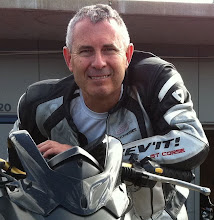These would have to be the cleanest, sweetest-smelling markets I've visited in all of my travels. The vegetables are laid out exquisitely, the meat and cheese is all behind refrigerated counters, and there's a general good feeling of everyone doing their trading and picking out their supplies.
I'd love to see more of this type of market proliferate in New Zealand - so much more interesting than sterile supermarkets and department stores.
My cunning plan hatched the previous day comes to fruition. Homeros has a fleet of bikes, and in no time at all Pauline and I are pedaling the 10kms to the beach.
Hmm - I wonder how much further :-) I must admit I've taken a liking to some of the more descriptive Turkish traffic signs.
Back at Homeros for the last time. We've really enjoyed the atmosphere and hospitality offered by Dervish and his team, and would gladly stay here again.
On the bus and we're on the way to Denizli, then on to Pamukkale. I take the opportunity for a nap and to update the blog, while Pauline abuses me for missing all the sights. I look out the window at a few scrubby olive trees - but she does have a point. I spot the odd wind turbine on the hills, and a geothermal power station. Coupled with the numerous solar hot water panels on the houses you get the feeling Turkey is making a concerted push to renewable energy.
Energy conservation is also seen in the almost complete absence of large gas guzzlers. Small cars and motorbikes proliferate, along with an excellent catered bus service. With petrol at over $4 per litre, behaviours are being driven in the right direction. NZ's AA squeals like a stuck pig when petrol hits $2 per litre - kiwi motorists don't know how lucky they are.
It gets hillier as we head inland towards Denizli, and the Anatolyan snow-capped mountains rise majestically into view. Fortunately it's not getting much colder outside - the daytime temperatures are ranging from 19 to 25 degrees with low humidity. Perfect for traveling.
We check in to our relative bland but perfectly acceptable Artemis Yoruk Guesthouse and plan the following day.
Pamukkale is a little town nestled at the foot of the famous travertines - calcium carbonate deposits arising from geothermal activity formed when the mineral-laden water cooled while cascading over the cliff tops. The Romans were so taken by the place they built a large spa city, Hieropolis, at the top of the hill to take advantage of the hot water's curative powers.
Our Sunday tour starts at the top and we pass through the necropolis as we approach the city.
The city's occupants took elaborate precautions to prevent their tombs being desecrated by grave robbers, with dire curses and Medusa images enscribed on them, and doors that could only be opened from the inside. Looters weren't put off, and all the tombs are smashed open to some degree, and a series of earthquakes have reduced many to rubble.
The entrance to Hieropolis is suitably grand through the Arch of Domitian, and that's the public latrine to the left. Apparently the men used to spend hours in here daily, chatting to their mates and catching up on news. Our guide suggests this hereditary behaviour continues to the current day, and explains why men of all cultures take magazines and newspapers into the loo and stay there all day. He may have a point!
We stop off for a swim at the 36 degree Antique Pool, thought to have been at the very centre of Hieropolis. It's a novel experience swimming over fluted marble columns two millennia old.
On to the 12,000 seat theatre. You may be able to pick out the high walls surrounding the arena - these were to prevent wild animals escaping into the crowd. I asked if Christians were fed to the lions here. Our guide wasn't sure, but thought it likely. Certainly there was no love lost between Romans and Christians in those days - Saint Philip was crucified by the Romans on the hill just behind Hieropolis.
This spot is Plutonium, a direct line to Hades. If you put your ear to the hole you can hear the bubbling and gurgling of carbon monoxide being given off. Realising that carbon monoxide was heavier than air, priests would take accused criminals into the chamber, taking care to keep their own heads high. The death of the criminal at the entrance to Hades was a sure sign of his guilt!
Despite being leveled by earthquakes a number of times, I'm intrigued by the resilience of the arches. One of engineering's "perfect forms", arches can withstand incredibly high vertical forces, and were the obvious choice for bridges for millennia.
Shoes off as we hit the travertines and make our way down the 40 minute walk back to the village. It's fairly hard going on the calcium deposit ridges underfoot, though they do give you grip on some of the slippery algae-coated sections. I wonder if the "white" of the pink and white terraces now lying at the bottom of Lake Tarawera once looked and felt like this.
Back at the guesthouse and we're intrigued to find a pair of swallows/martins building a mud nest on the concrete wall of our balcony. It's a shame we can't stay to see it finished with a couple of chicks in it. But travelers must press on - just another full day in Turkey before we hit the Greek Islands!
- Posted using BlogPress from my iPad

No comments:
Post a Comment